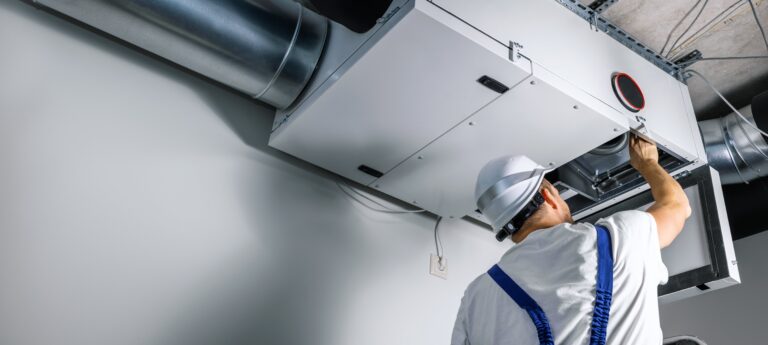To make this measure more effective and tailored to the specific context of your company, we recommend that you first perform an overall analysis of your energy situation.
Controlling good ventilation and the operating costs associated with your company’s centralised ventilation system
The main function of a ventilation system is to ensure a pleasant climate and high air quality within the establishment. This need is associated with energy consumption (generally in continuous service) and must be used in the best possible way.
Definition of requirements with a view to optimising mechanical ventilation
Identification of the needs of different building functions
- Pour évaluer les besoins actuels, il est important de prendre en considération les paramètres suivants :
- renouve
- To assess current needs, it is important to consider the following parameters:
- air exchange in (m3/h)/p
- temperature (outside and inside)
- moisture content (drying or humidification required?)
- required air quality (CO2 levels, fine particles, etc.)
- use and intensity of use of building zones
- The safety regulations of the ITM “Ventilation and air-conditioning systems” must be complied with.
- Identify potential malfunctions, e.g. air flow noise, temperature or pressure variations, incorrect handling, continuous operation of installations.
Further information
- The main tasks of an consulting engineering office (technical consultant) or a qualified craftsman (ventilation installer) in optimising ventilation are as follows:
- carry out an in-depth inventory of the infrastructure (possible co-financing)
- analyse energy consumption in relation to ventilation requirements
- check that the entire ventilation system is working properly
- optimise system regulation, e.g. as a function of CO2 levels
- check that the heat recovery system is working properly
Implementation of optimisation measures for mechanical ventilation
Control based on actual use
- Adjust to actual needs
- Check operating time
- Shut down or reduce to a minimum the ventilation system outside operating hours (nights, weekends, etc.)
- If possible, set the fan speed to the required level using a variable frequency drive
Temperature-dependent control
- Set the temperature level according to the specific needs of the different rooms
- It is recommended to use control devices such as a control unit, thermostat, or centralised regulation, etc.
- Reduce manual ventilation (air exchange depending on activity, number of people and size) in heated rooms to a minimum
- Setting the air preheating/cooling in the ventilation system
Measuring air quality

- Install measuring instruments, e.g. thermometer, CO2 measurement, humidity (hygrometer), fine particles, etc. A recommendation of the temperature instructions for the various workplaces can be found in safety regulation ITM-SST 1814.1.
- Adjust the airflow rate according to the quality parameters (e.g. CO2 level).
Humidification
If the ventilation system is equipped with a humidifier, the system and the corresponding water treatment plant should be checked regularly to ensure correct operation.
Maintenance of the ventilation system
The maintenance intervals and instructions laid down by the supplier must be observed. This includes cleaning the system, replacing filters, checking flow rates and ensuring that the ventilation system is set up correctly.
Heat recovery

- We recommend that you regularly check that the heat recovery unit is working properly.
- The flow of incoming air and the flow of outgoing air must be matched to each other.
- Ensure that measuring instruments are working properly. Small errors can have a big influence on the control parameters.
- Check the heat exchanger for dirt and have it cleaned if necessary, following the manufacturer’s instructions.
Subsidy application
Government subsidies
Attention : effet incitatif à respecter pour la demande d’aides (étatiques ou non) et sous réserve de remplir les conditions d’éligibilité.
To respect the “incentive effect”, no binding commitment (signing a quotation; paying a deposit) may be made BEFORE submitting the application file or receiving the agreement in principle from the State or the electricity and natural gas supplier following a subsidy application.
- Financial Aid for small and medium-sized enterprises covering up to 70% of eligible costs for the implementation of a project aimed at reducing the environmental impact. The eligible project budget must be in a range from 3.000 € to 25.000 € excl. VAT.
- For more information:
- Chambre des Métiers for craft companies
- Chamber of Commerce for businesses in the non-craft sectors
SME aid scheme – Aid for miscellaneous investments
- Subsidies for small and medium-sized businesses, up to 10 % or 20 % of the amount of miscellaneous investments aimed at promoting the modernisation and competitiveness of the Luxembourg economy.
- Verification of company eligibility and costs: Ministry of the Economy (Department for Support to SMEs)
- For questions:
- House of Entrepreneurship of the Chamber of Commerce
- Chambre des Métiers (Chamber of Skilled Trades and Crafts)
N.B. State subsidies cannot be combined for the same project.
Application for subsidies from electricity and natural gas suppliers
Since 2015, natural gas and electricity suppliers have been required to make energy savings for consumers under the obligation scheme. Since then, energy suppliers have been offering support and advice, as well as subsidy programmes for consumers to implement energy efficiency measures.
The following suppliers offer this service for companies:
N.B. Supplier subsidies can be combined with any state subsidies for the same project.
